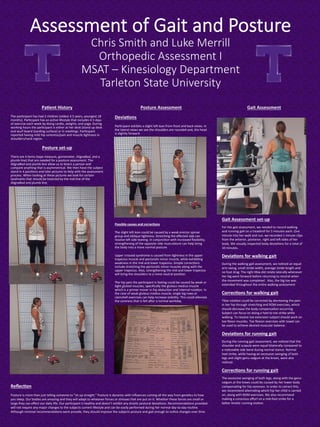
Smith-Merrill Posture_Gait Assessment
- 1. Assessment of Gait and Posture Chris Smith and Luke Merrill Orthopedic Assessment I MSAT – Kinesiology Department Tarleton State University Gait Assessment Posture Assessment Devia1ons Par$cipant exhibits a slight le2 lean from front and back views. In the lateral views we see the shoulders are rounded and, the head is slightly forward. Possible causes and correc1ons The slight le2 lean could be caused by a weak erector spinae group and oblique $ghtness. Stretching the effected side can resolve le2 side leaning. In conjunc$on with increased flexibility, strengthening of the opposite side musculature can help bring the body into a more normal posture. Upper crossed syndrome is caused from $ghtness in the upper trapezius muscle and pectoralis minor muscle, while exhibi$ng weakness in the mid and lower trapezius. Simple correc$ons include stretching the pectoralis minor muscles along with the upper trapezius. Also, strengthening the mid and lower trapezius will bring the shoulders to a more neutral posi$on. The hip pain the par$cipant is feeling could be caused by weak or $ght gluteal muscles, specifically the gluteus medius muscle which is a primer mover in hip abduc$on and internal rota$on. In the case of weak gluteus medius muscle, single leg rows or clamshell exercises can help increase stability. This could alleviate the soreness that is felt a2er a normal workday. Pa1ent History The par$cipant has had 2 children (oldest 4.5 years, youngest 18 months). Par$cipant has an ac$ve lifestyle that includes 4-5 days of exercise each week by doing cardio, weights, and yoga. During working hours the par$cipant is either at her desk (stand up desk and wurf board standing surface) or in mee$ngs. Par$cipant reported having mild hip soreness/pain and muscle $ghtness in shoulders/neck region. Posture set-up There are 4 items (tape measure, goniometer, AlignaBod, and a plumb-line) that are needed for a posture assessment. The AlignaBod and plumb-line allow us to bisect a person and compare anything that is asymmetrical. We then have the subject stand in 4 posi$ons and take pictures to help with the assessment process. When looking at these pictures we look for certain landmarks that should be bisected by the mid line of the AlignaBod and plumb-line. Gait Assessment set-up For the gait assessment, we needed to record walking and running gait on a treadmill for 5 minutes each. One minute into her walk and run, we recorded 1 minute clips from the anterior, posterior, right and le2 sides of her body. We visually inspected body devia$ons for a total of 10 minutes. Devia1ons for walking gait During the walking gait assessment, we no$ced an equal arm swing, small stride width, average stride length and no foot drag. The right $bia did rotate laterally whenever her leg went forward before returning to neutral when the movement was completed. Also, the big toe was extended throughout the en$re walking assessment Correc1ons for walking gait Tibia rota$on could be corrected by decreasing the pain in her hip through stretching and ROM exercises, which should decrease the body compensa$on occurring. Subject can focus on doing a heel to toe strike while walking. To resolve toe extension subject should work on toe flexor muscles. Toe flexion exercises with towel can be used to achieve desired muscular balance. Devia1ons for running gait During the running gait assessment, we no$ced that the shoulder and scapula were equal bilaterally compared to a no$ceable side bend during normal stance. Normal heel strike, while having an excessive swinging of both legs and slight genu-valgum at the knees, were also no$ced. Correc1ons for running gait The excessive swinging of both legs, along with the genu- valgum at the knees could be caused by her lower body compensa$ng for hip soreness. In order to correct this, we recommend alterna$ng which hip her child is carried on, along with ROM exercises. We also recommend making a conscious effort on a mid-foot strike for a be[er kine$c running mo$on. Reflec1on Posture is more than just telling someone to “sit up straight.” Posture is dynamic with influences coming all the way from gene$cs to how you sleep. Our bodies are amazing and they will adapt to whatever forces or stresses that are put on it. Whether these forces are small or large they can effect our daily life. Our par$cipant is healthy and doesn’t exhibit any dras$c postural devia$ons. Recommenda$ons provided will not require any major changes to the subjects current lifestyle and can be easily performed during her normal day-to-day rou$ne. Although minimal recommenda$ons were provide, they should improve the subjects posture and gait enough to no$ce changes over $me.